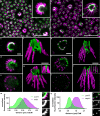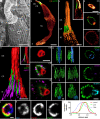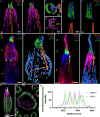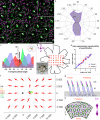Planar polarity in primate cone photoreceptors: a potential role in Stiles Crawford effect phototropism
- PMID: 35075261
- PMCID: PMC8786850
- DOI: 10.1038/s42003-021-02998-y
Planar polarity in primate cone photoreceptors: a potential role in Stiles Crawford effect phototropism
Abstract
Human cone phototropism is a key mechanism underlying the Stiles-Crawford effect, a psychophysiological phenomenon according to which photoreceptor outer/inner segments are aligned along with the direction of incoming light. However, such photomechanical movements of photoreceptors remain elusive in mammals. We first show here that primate cone photoreceptors have a planar polarity organized radially around the optical center of the eye. This planar polarity, based on the structure of the cilium and calyceal processes, is highly reminiscent of the planar polarity of the hair cells and their kinocilium and stereocilia. Secondly, we observe under super-high resolution expansion microscopy the cytoskeleton and Usher proteins architecture in the photoreceptors, which appears to establish a mechanical continuity between the outer and inner segments. Taken together, these results suggest a comprehensive cellular mechanism consistent with an active phototropism of cones toward the optical center of the eye, and thus with the Stiles-Crawford effect.
© 2022. The Author(s).
Conflict of interest statement
The authors declare no competing interests.
Figures







References
-
- Stiles WS. The luminous efficiency of monochromatic rays entering the eye pupil at different points and a new colour effect. Proc. R. Soc. Lond. Ser. B Biol. Sci. 1937;123:90–118.
-
- Laties, A. M. & Enoch, J. M. An analysis of retinal receptor orientation I. Angular relationship of neighboring photoreceptors. Investig. Ophtalmol. 10, 69–77 (1971). - PubMed
-
- Laties AM, Liebman PA, Campbell CE. Photoreceptor orientation in the primate eye. Nature. 1968;218:172–173. - PubMed
-
- Alan AM. Histological techniques for study of photoreceptor orientation. Tissue Cell. 1969;1:63–81. - PubMed
-
- Applegate MA, Bonds AB. Induced movement of receptor alignment toward a new pupillary aperture. Investig. Ophthalmol. Vis. Sci. 1981;21:869–873. - PubMed
Publication types
MeSH terms
Grants and funding
LinkOut - more resources
Full Text Sources

